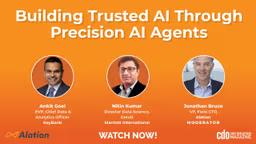AI News Bureau
Verizon CDAIO Mano Mannoochahr on Governing AI at Unprecedented Scale
Written by: CDO Magazine Bureau
Updated 12:24 PM UTC, Tue October 7, 2025
As one of the world’s largest telecommunications companies, Verizon serves more than 143 million customers across the U.S. and operates one of the largest wireless networks in the world. The company invests heavily in advanced technologies and has consistently ranked among the top in 5G deployment and innovation. Against this backdrop of scale and complexity, the company’s approach to data and AI is both a technical and cultural transformation.
The first part of this three-part series unpacked the evolving role of data and AI leadership, the architecture behind Verizon’s AI strategy, and how applied AI is transforming both customer and employee experiences.
In this second part of the conversation, Mano Mannoochahr, Chief Data Analytics and AI Officer at Verizon, speaks with Jeff Burlin, Senior Director of Executive Engagement Programs at Twilio, about how Verizon is aligning AI strategy with C-suite priorities, building a robust data foundation, and scaling adoption through partnerships and employee empowerment.
Governing AI from the top down
Mannoochahr explains that cross-functional alignment begins with structure. “At the highest level, we’ve got an AI council that I chair. The council meets every month and is attended by SVPs across the company representing all of our businesses, as well as more critical functions.”
Below this strategic body sits an operating council that addresses tactical issues before they escalate to the AI council. Together, these governance layers ensure the AI strategy is not only aligned with enterprise goals but also agile in execution.
With a framework in place, the company can continuously revisit priorities. “The aperture for opportunities and use cases just continues to expand as AI is maturing and advancing,” Mannoochahr notes. “We have active dialogue around what our roadmap looks like, and we’re always revisiting and prioritizing the most important things.”
Data as the bedrock of AI
For Verizon, AI innovation begins with disciplined data management. “You have to ensure the right foundation, which starts with having quality data and the right domain models,” he emphasizes. “AI by itself isn’t enough. You’ve got to have the right data, organized the right way.”
Mannoochahr further shares that the foundation is being built through the One Verizon data program, migrating one of the world’s largest datasets to the cloud. “Hopefully by the end of next year, we’ll have all of our data in the cloud,” he says, adding that the move to next-generation warehouses and semantic layers will “unleash and enable the next 10 years” for the organization in analytics and AI.
Build, buy, and partner: A hybrid approach
When it comes to technology strategy, Mannoochahr stresses flexibility. “Generative AI and its ability to generate code actually have created another dialogue,” he explains. Verizon is weighing when to build proprietary tools, when to leverage partners, and when to let AI fill in the gaps.
Google Cloud Platform serves as Verizon’s foundation, with Google Gemini powering much of the company’s AI adoption. “Wherever we have gaps, we’re partnering with the ecosystem,” Mannoochahr says.
In some cases, Verizon builds stopgap solutions, then transitions to vendor offerings as technology matures. This hybrid approach allows the company to be what he calls an “informed buyer” while also shaping the market in collaboration with startups and partners.
Measuring success: Same metrics, faster outcomes
Unlike many companies defining new AI-specific KPIs, Verizon is measuring AI success against its core business imperatives. “It’s largely the same metrics that we’ve always had,” Mannoochahr says, citing customer retention, acquisition, network quality, and product growth. The difference lies in acceleration. “It’s about figuring out how to move the needle further and do an even better job of growing our business, our company, and making our customers happier with us and our offerings.”
Adoption metrics also matter. Verizon monitors where teams are on the adoption curve and whether solutions have crossed the inflection point of over 50% adoption. “In some cases, the value might be just learning out of the experiment we made,” he adds, underscoring the balance of speed and learning in early AI initiatives.
Driving an AI-first culture
Perhaps the most striking development is how quickly AI has permeated Verizon’s workforce.
“The opportunity to drive an AI-first culture has gone from not just the front lines but also up the pyramid of knowledge work inside businesses,” Mannoochahr observes. Verizon has rolled out Google Gemini to more than 100,000 employees, with adoption rates surpassing 50% within a month, he adds.
“HR is actually leading the chart — they’re at 82% adoption,” Mannoochahr says, noting that marketing and communications teams are also embracing the technology. At a recent leadership meeting of 500 people, he recalls that virtually every hand went up when asked if they were using Gemini.
Employees are using AI for everything from inbox management and presentation creation to leveraging Gemini Gems for custom knowledge work. “How do we take drudgery out of people’s daily work? How do we make the job of collecting data and information easier and better?” Mannoochahr asks. For him, the answer lies in embedding AI seamlessly into workflows.
He concludes with a vision of AI as a force multiplier across Verizon. “At Verizon, we’re using AI to build a better business, a better customer and employee experience, and to make the best network even better,” he says.
CDO Magazine appreciates Mano Mannoochahr for sharing his insights with our global community.





